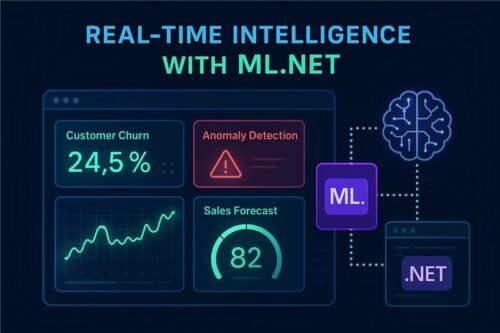Using ML.NET for Real-Time Predictions in .NET Applications
In today’s data-driven enterprise landscape, integrating machine learning directly into your .NET applications can unlock powerful, real-time insights. ML.NET, Microsoft’s open-source machine learning framework, enables developers to build, train, and deploy predictive models within the .NET ecosystem — without needing prior expertise in data science.
What Is ML.NET?
- ML.NET allows you to create custom machine learning models using C# or F#. It supports a wide range of scenarios including:
- Sentiment analysis
- Product recommendations
- Anomaly detection
- Forecasting and classification
- Image recognition
Its tight integration with ASP.NET Core and Azure makes it an ideal choice for enterprises looking to enhance their applications with intelligent behavior.
Real-Time Predictions with ML.NET:
Real-time ML applications require models that can respond immediately to user interactions or incoming data. ML.NET supports this with:
- Streaming APIs for handling live data.
- Prediction Engine for fast, single-record predictions.
- Model retraining pipelines for adapting to new data without redeployment.
Common Real-Time Use Cases
- Fraud Detection – Instantly flagging abnormal transactions in fintech apps.
- Inventory Forecasting – Adjusting warehouse operations dynamically.
- Churn Prediction – Reacting to at-risk customer behaviors in SaaS apps.
- Personalization – Delivering real-time recommendations on websites or platforms.
How to Integrate ML.NET in Your .NET Application:
- Define Data Schema – Structure your input and output fields.
- Load and Train – Use training datasets to create your model.
- Evaluate – Check performance with metrics like accuracy, AUC, etc.
- Deploy – Embed the model into your .NET Core app or Web API.
For scalable real-time scenarios, ML.NET models can also be hosted in containers or integrated with Azure ML endpoints.
Tools That Enhance ML.NET Real-Time Capabilities:
- Model Builder – No-code interface for generating ML.NET pipelines.
- ONNX Runtime – High-performance inference engine.
- ML Ops on Azure – For enterprise-grade model lifecycle management.
Future-Proofing Your Applications:
By embedding ML.NET models into your enterprise applications, you enable them to adapt and grow with your business. This approach supports the broader digital transformation goals of modern organizations, particularly when paired with scalable backend systems like ASP.NET Core and microservices.
Final Thoughts
For enterprises seeking intelligent automation, integrating ML.NET with .NET Core is a future-ready solution. It eliminates dependency on external services while delivering performance, scalability, and full control.


